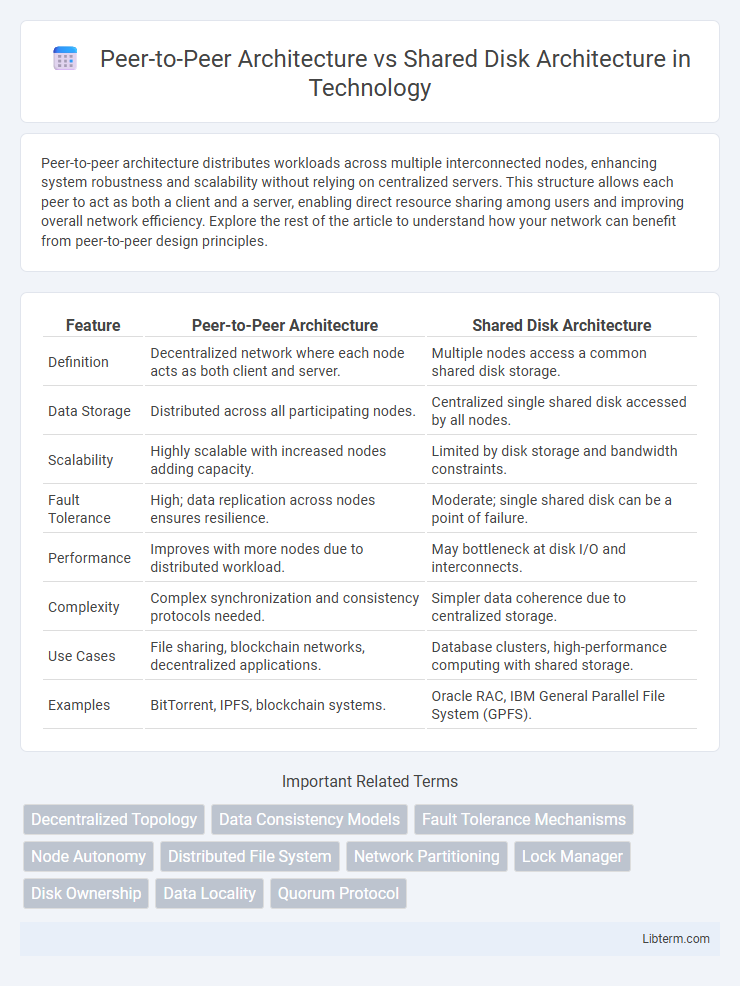Peer-to-peer architecture distributes workloads across multiple interconnected nodes, enhancing system robustness and scalability without relying on centralized servers. This structure allows each peer to act as both a client and a server, enabling direct resource sharing among users and improving overall network efficiency. Explore the rest of the article to understand how your network can benefit from peer-to-peer design principles.
Table of Comparison
| Feature | Peer-to-Peer Architecture | Shared Disk Architecture |
|---|---|---|
| Definition | Decentralized network where each node acts as both client and server. | Multiple nodes access a common shared disk storage. |
| Data Storage | Distributed across all participating nodes. | Centralized single shared disk accessed by all nodes. |
| Scalability | Highly scalable with increased nodes adding capacity. | Limited by disk storage and bandwidth constraints. |
| Fault Tolerance | High; data replication across nodes ensures resilience. | Moderate; single shared disk can be a point of failure. |
| Performance | Improves with more nodes due to distributed workload. | May bottleneck at disk I/O and interconnects. |
| Complexity | Complex synchronization and consistency protocols needed. | Simpler data coherence due to centralized storage. |
| Use Cases | File sharing, blockchain networks, decentralized applications. | Database clusters, high-performance computing with shared storage. |
| Examples | BitTorrent, IPFS, blockchain systems. | Oracle RAC, IBM General Parallel File System (GPFS). |
Introduction to Distributed Systems Architectures
Peer-to-peer architecture in distributed systems enables nodes to share resources directly without requiring a central server, promoting scalability and fault tolerance. Shared disk architecture allows multiple computers to access a common disk storage, offering high availability and simplified data management. Both architectures serve distinct purposes in distributed systems design, balancing resource sharing, performance, and reliability.
Defining Peer-to-Peer Architecture
Peer-to-peer architecture is a decentralized network design where each node, or peer, acts as both a client and a server, sharing resources directly without relying on a central coordinator. This architecture enhances scalability and fault tolerance by distributing data and processing tasks across multiple interconnected peers. Unlike shared disk architecture, which centralizes storage access through a common disk subsystem, peer-to-peer systems enable autonomous nodes to communicate and collaborate independently.
Overview of Shared Disk Architecture
Shared Disk Architecture features multiple servers connected to a common disk storage, allowing all nodes to access the same data simultaneously for improved redundancy and scalability. This design enables efficient resource sharing and high availability by providing concurrent read/write access while maintaining data consistency through coordination protocols. It contrasts with Peer-to-Peer Architecture by centralizing data storage rather than distributing data across nodes, reducing the complexity of data synchronization.
Core Differences: Peer-to-Peer vs Shared Disk
Peer-to-peer architecture features nodes with equal responsibilities that communicate directly, enabling decentralized data sharing and fault tolerance. Shared disk architecture relies on multiple nodes accessing a common storage system, allowing coordinated data management but requiring synchronization mechanisms to prevent conflicts. Core differences include decentralization and node equality in peer-to-peer systems versus centralized storage access and coordination overhead in shared disk systems.
Scalability Comparison
Peer-to-peer architecture offers superior scalability by enabling each node to act as both client and server, distributing load and minimizing bottlenecks as the system grows. Shared disk architecture faces scalability challenges due to centralized disk access, which can create contention and latency when multiple nodes attempt simultaneous data retrieval. Consequently, peer-to-peer systems are better suited for large-scale environments requiring high availability and dynamic resource allocation.
Data Consistency and Management
Peer-to-Peer Architecture ensures data consistency through decentralized control, with each node managing its own data copies, often requiring sophisticated synchronization protocols to avoid conflicts. Shared Disk Architecture centralizes data storage, enabling multiple nodes to access a single disk system, which simplifies consistency management but necessitates complex locking mechanisms to prevent concurrent access issues. Effective data management in Peer-to-Peer systems relies on distributed consensus algorithms, while Shared Disk systems depend on robust concurrency control and cache coherence techniques.
Fault Tolerance and Reliability
Peer-to-peer architecture enhances fault tolerance by decentralizing control, allowing nodes to continue operations independently during failures, which increases overall system reliability. In contrast, shared disk architecture relies on a common storage medium accessible by multiple nodes, where fault tolerance depends on robust disk subsystem redundancy but may suffer from a single point of failure in storage access. Distributed consensus mechanisms and data replication in peer-to-peer systems further improve reliability compared to the shared disk approach, which often requires complex coordination to maintain consistency and availability.
Performance and Network Efficiency
Peer-to-peer architecture enhances performance by distributing workload across multiple nodes, reducing bottlenecks and enabling parallel processing, which improves network efficiency through direct data exchange between peers. Shared disk architecture centralizes storage access, often causing contention and increased latency as multiple nodes coordinate access, leading to potential performance degradation under high loads. Network efficiency in peer-to-peer systems benefits from reduced data transfer hops, while shared disk systems rely heavily on centralized disk controllers, which can become network performance bottlenecks.
Use Cases and Industry Applications
Peer-to-Peer architecture excels in decentralized file sharing, blockchain networks, and collaborative platforms where direct node communication ensures scalability and fault tolerance. Shared Disk architecture suits database clusters, enterprise storage systems, and high-availability applications requiring fast, consistent access to a common disk subsystem across multiple servers. Industries like finance, telecommunications, and cloud computing leverage Shared Disk for transactional integrity, while Peer-to-Peer is favored in decentralized networks and distributed computing environments.
Choosing the Right Architecture
Choosing the right architecture between Peer-to-Peer and Shared Disk depends on factors such as scalability, fault tolerance, and data consistency requirements. Peer-to-Peer architecture excels in distributed systems requiring high scalability and fault tolerance, enabling each node to act as both a client and server. Shared Disk architecture suits environments prioritizing data consistency and concurrent access, as multiple nodes share a common disk system with centralized management.
Peer-to-Peer Architecture Infographic

 libterm.com
libterm.com